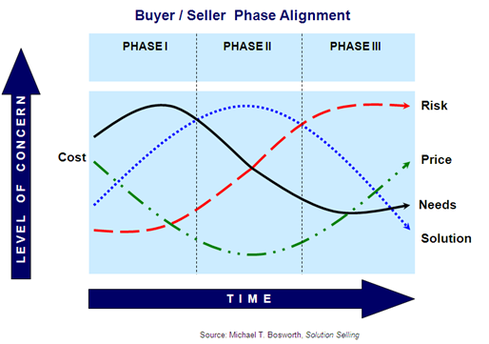 I read an interesting blog posting from Peter Bregman on the Harvard Business Review website, How Not to Lose a Sale. In the article, Peter shares a recent sales experience we can all learn from. To summarize, Peter loses a highly qualified sales opportunity by jumping to a proposed solution too early in the sales process. A friend of Peter's worked with the prospect and sponsored the meeting. The prospect was expecting to gain a better understanding of his issues by exploring the underlying cause(s). Once in the meeting, Peter, excited for the opportunity and eager to show his preparedness and expertise, began suggesting ways to solve the issue before allowing the prospect to discuss his view of the situation. Peter also ignored the recommendation of his sponsor to postpone an aspect of the discussion until a later time. As a result, the prospect was disappointed and failed to make a connection with Peter. Peter attributed his poor performance to a lack of “attunement”, a recent concept on persuasion that stresses the importance of appreciating the perspective of others. There were a couple reasons I liked this story. First, the sales scenario described hit painfully close to home. I’ve had similar experiences several times during my career. Maybe due to personality type, over-excitement, or desire for recognition, I’ve made the same mistake. It's an easy trap to fall into when face-time with busy executives is brief and competitors are close behind. Regardless of experience level, we can all benefit from this lesson. The irony is that it was Peter’s confidence, experience, and preparedness that diminished his chance of winning the sales opportunity; one that was his to lose. Second, Peter cites the recent research on influencing others in a book by Daniel Pink, To Sell Is Human: The Surprising Truth About Moving Others. Buyer alignment, a similar sales process concept to attunement, has been addressed by several sales experts and researchers over the years. It's one of the most important concepts taught to sales professionals. Although alignment is not identical to attunement, it also trains sellers to stay synchronized with the buyer’s thoughts and concerns throughout their buying decision process. While attunement may keep us empathetic with the buyer's perspective during the buying process, alignment reminds us that buying priorities and concerns shift throughout the process. Leveraging the two concepts will make you a better sales professional and improve your win-loss ratio. Here is a chart illustrating the phases of buyer/seller alignment from Michael Bosworth’s book Solution Selling; Creating Buyers in Difficult Selling Markets. What Does the Buyer/Seller Alignment Chart Tell Us? The seller must be aligned with the phases of buyer concerns to be successful. In Phase I the buyer is most interested in thoroughly researching and understanding the issue they are facing. Accordingly, this must be your primary concern in this phase as well. In Phase II, the buyer is focused on possible solutions to their problem. This is the time to present and discuss how your offer provides the best approach to resolve Phase I issues. By Phase III, the buyer has decided on the best partner and is performing additional calculations on any risks associated with their selection. Peter’s experience was a classic case of buyer/seller misalignment. In the meeting, the buyer wanted to gain a better understanding of the issues and root causes (Phase I). Peter was eager to talk about his past knowledge and experience solving similar issues (Phase II). Their expectations for the meeting were not aligned. The prospect became frustrated and felt pressured and “sold-to”. The seller was confused as to why a better connection was not made. The disappointed buyer will now have to look for additional sellers who might be in better alignment. If the next seller can stay aligned and attuned, they have a much better chance of becoming this prospect’s solution partner. In Peter’s post meeting self-critique, he concludes that he should have taken a less prominent role in the meeting by, ”sitting in the chair he was offered, listening to the prospect tell his story, seeing the situation from his eyes, analyzing it from his point of view and feeling his emotions...” What I felt was needed (to borrow a phrase from a recent national foreign policy debate) was a philosophy of “leading from behind”--taking an ultra-patient, listening posture and judiciously reserving value-add comments and ideas until follow-on meetings. In doing so, Peter might have minimized the perception of being controlling or “pushy” until after his prospect had completed Phase I. He also should have followed his sponsor’s advice to postpone one specific topic until a follow-on meeting. Learnings From Peter's Experience
Summary Learn from, but don’t overreact to, a single experience. Every interaction will be different. When in doubt, ask what you wanted to ask and say what you wanted to say while you’re there--it may be your only opportunity. You can’t practice chemistry. Be authentic and try your best to be attuned and aligned. In spite of what some “experts” say, don’t try and change who you are for each prospect. Your next prospect may appreciate the confidence and strength of your style. Chair size and heights don’t matter, new ideas and situational knowledge does. Just don’t risk taking the seat at the head of the table...
0 Comments
Your comment will be posted after it is approved.
Leave a Reply. |
AuthorMike Peters is the managing director of the Whitespace Consulting Group, a global business development strategy firm. The Whitespace Consulting Group has been helping multi-cultural clients optimize their business development strategy since 2005. He can be reached at mpeters@whitespace-consulting.com. |
